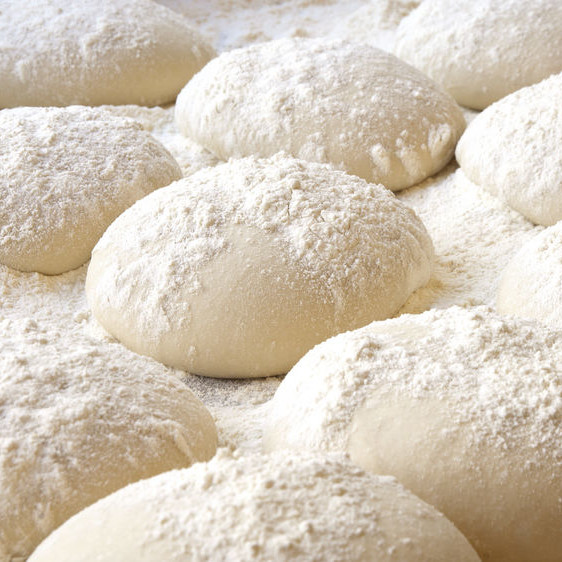
Gluten Quality
What is Gluten Quality?
Gluten quality refers to the contribution of gluten-forming proteins – gliadin and glutenin – of different cereals (and their dry processed, milled and sprouted products) to the rheological and other handling properties of yeast-leavened bakery products.
In order to obtain a good bread volume, the dough structure provided by gluten should be able to entrap the carbon dioxide produced by yeast cells and expand during fermentation.
How does it work?
Gluten quality of cereal flours is impacted by two factors:
- Inherent factors
- Genetics (cultivar, variety)
- Environmental (e.g. soil conditions, temperature, rainfall, snow)
- Interaction between genetics and environmental conditions
- Milling and processing factors
- Cleaning process
- Wheat blending
- Tempering conditions
- Roller settings
- Sifter and purifier settings
- Extraction rate
A deeper look at gluten-forming proteins
Gluten is a heterogeneous mixture of high molecular weight proteins, prolamin (gliadins) and glutelin (glutenins). Both have very limited solubility in water. Upon their encounter with water and subsequent mixing, they form a continuous macromolecular viscoelastic network within the dough that is capable of entrapping gas during fermentation.
Amino acid composition of these proteins, their molecular interactions (intra- and inter-), respective ratio in total gluten, as well as the proportion of low molecular weight (LMW) glutenin subunits and high-molecular weight (HMW) glutenin subunits are all contributing factors to gluten performance and overall quality.1
The following table highlights protein composition of wheat flour:1,2,3,4
| Component | Percent (%) | Molecular weight | Comments |
| Total protein | 7–15 | – |
An important component of flour specifications (14% moisture basis) |
| Albumins (non-gluten forming, soluble in water) | 15 (of total protein) | – | Not crucial to bread baking quality |
| Globulins (non-gluten forming, soluble in salt solutions) | 3 (of total protein) | – | Not crucial to bread baking quality |
| Prolamins (gliadins, α,β,γ and ω fractions)(gluten-forming, soluble in alcohol solutions) | 33 (of total protein)30–45 (of total gluten) | 30,000–50,000 Da | Essential components for dough extensibility and viscoelasticity. |
| Glutelins (glutenins)(gluten-forming, soluble in dilute acids) |
16 (of total protein) 70–55 (of total gluten) |
High molecular weight (90,000 to 10 millions Da)Low molecular weight < 90,000 |
Very large molecules made up of individual subunits (heterogeneous polypeptides) connected by disulfide bonds. They confer dough elasticity and resistance to deformation. |
| Residue | 33 of total protein | – | Protein left after dissolution with solvents. |
Application
Gluten quality is not only limited to wheat. There are other cereals that provide gluten-forming proteins and as a consequence, can be used for production of breads on their own or combined with wheat. When alternative cereal ingredients are used in bread and other bakery formulations, their impact on wheat proteins should be addressed.
| Cereal | Presence of Gliadins | Presence of Glutenins | Gluten Forming Ability | Gluten Quality |
| Modern, common wheat (Triticum aestivum) | Yes | Yes | Yes | Excellent |
| Durum wheat (Triticum durum) | Yes | Yes | Yes | Very good |
| Ancient wheat (covered caryopsis) Eikorn, small spelt | Yes | Yes | Yes | Good* |
| Ancient wheat (covered caryopsis) Emmer, farro | Yes | Yes | Yes | Good* |
| Ancient wheat (covered caryopsis) Spelt, dinkel | Yes | Yes | Yes | Good* |
| Ancient wheat (covered caryopsis) Kamut® | Yes | Yes | Yes | Good* |
| Triticale (Man‐made cross of wheat and rye) | Yes | Yes | Yes | Acceptable** |
| Rye | Yes | No | No | Poor* |
| Barley | No | No | No | Absent |
| Oats | No | No | No | Absent |
| Corn | No | No | No | Absent |
| Millets | No | No | No | Absent |
| Sorghum | No | No | No | Absent |
| Rice | No | No | No | Absent |
| Pseudocereals (quinoa, amaranth, buckwheat) | No | No | No | Absent |
* Requires formulation and processing adjustments for optimum bread quality
** Less / weaker gluten‐forming proteins than common and ancient wheats
Gluten quality and baking quality
In most cases, bakers know about gluten quality as baking quality. This is because gluten is essential in breadmaking operations which represent the largest market share.
Besides chemical analysis (compositional- and molecular-focused), gluten quality can be assessed by using dough testing instruments. Such devices rely on the rheological behavior, mechanical response and water interactions of flours (and the respective doughs).
References
- Shewry, P.R., et al. “Wheat Grain Proteins.” Wheat Chemistry and Technology, 4th edition, AACC International, Inc., 2009, pp. 223–278.
- Finnie, S., and Atwell, W.A. “Composition of Commercial Flour.” Wheat Flour Handbook, 2nd edition, AACC International, Inc., 2016, pp. 31–40.
- Rosell, C.M. “Bread: Chemistry of Baking.” Encyclopedia of Food and Health, volume 1, Academic Press, Elsevier Ltd., 2016, pp. 484–487.
- Damodaran, S. “Amino Acids, Peptides, and Proteins.” Fennema’s Food Chemistry, 5th edition, CRC Press, Taylor & Francis Group, LLC, 2017, pp. 318–321.

